Intel Core i7-11700K Review: Blasting Off with Rocket Lake
by Dr. Ian Cutress on March 5, 2021 4:30 PM EST- Posted in
- CPUs
- Intel
- 14nm
- Xe-LP
- Rocket Lake
- Cypress Cove
- i7-11700K
Gaming Tests: Gears Tactics
Remembering the original Gears of War brings back a number of memories – some good, and some involving online gameplay. The latest iteration of the franchise was launched as I was putting this benchmark suite together, and Gears Tactics is a high-fidelity turn-based strategy game with an extensive single player mode. As with a lot of turn-based games, there is ample opportunity to crank up the visual effects, and here the developers have put a lot of effort into creating effects, a number of which seem to be CPU limited.
Gears Tactics has an in-game benchmark, roughly 2.5 minutes of AI gameplay starting from the same position but using a random seed for actions. Much like the racing games, this usually leads to some variation in the run-to-run data, so for this benchmark we are taking the geometric mean of the results. One of the biggest things that Gears Tactics can do is on the resolution scaling, supporting 8K, and so we are testing the following settings:
- 720p Low, 4K Low, 8K Low, 1080p Ultra
For results, the game showcases a mountain of data when the benchmark is finished, such as how much the benchmark was CPU limited and where, however none of that is ever exported into a file we can use. It’s just a screenshot which we have to read manually.
If anyone from the Gears Tactics team wants to chat about building a benchmark platform that would not only help me but also every other member of the tech press build our benchmark testing platform to help our readers decide what is the best hardware to use on your games, please reach out to ian@anandtech.com. Some of the suggestions I want to give you will take less than half a day and it’s easily free advertising to use the benchmark over the next couple of years (or more).
As with the other benchmarks, we do as many runs until 10 minutes per resolution/setting combination has passed. For this benchmark, we manually read each of the screenshots for each quality/setting/run combination. The benchmark does also give 95th percentiles and frame averages, so we can use both of these data points.
| AnandTech | Low Resolution Low Quality |
Medium Resolution Low Quality |
High Resolution Low Quality |
Medium Resolution Max Quality |
| Average FPS | 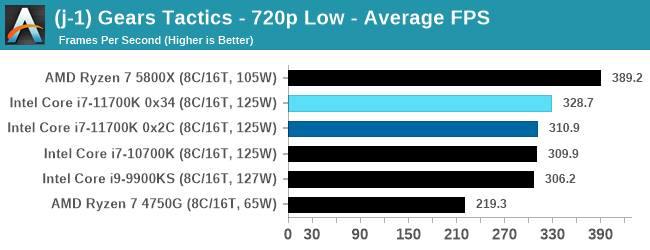 |
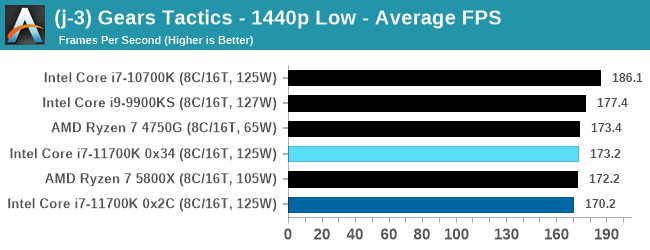 |
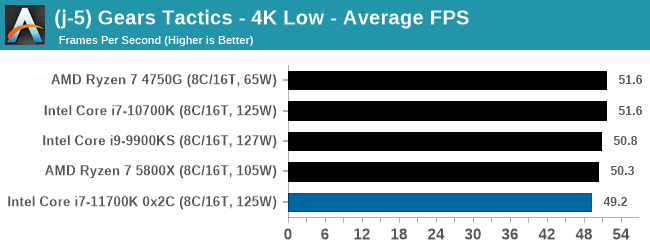 |
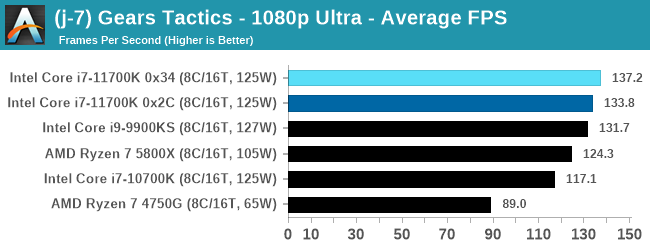 |
| 95th Percentile | 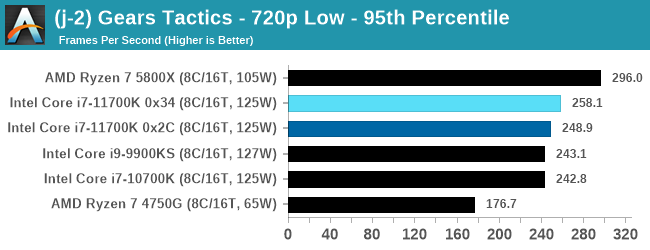 |
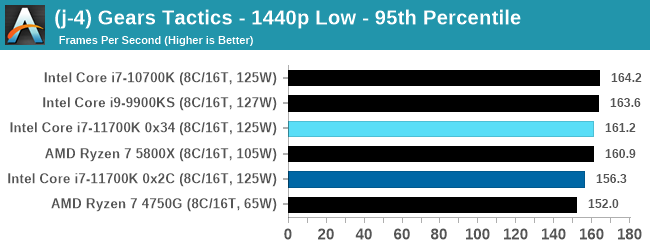 |
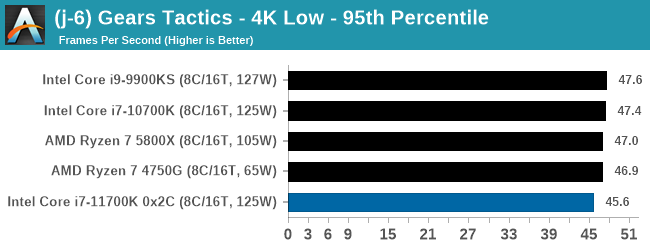 |
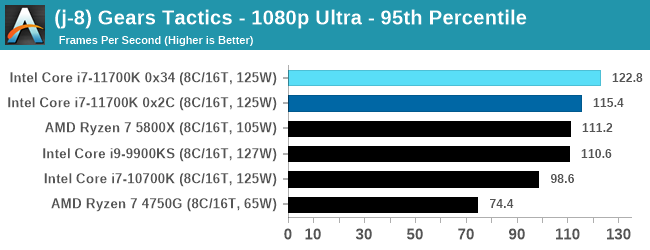 |
Gears is the one test where at our 1080p Maximum settings it shines ahead of the pack. Although at high resolution, low quality, although all five CPUs are essentially equal, it still sits behind AMD's Ryzen APU.
All of our benchmark results can also be found in our benchmark engine, Bench.


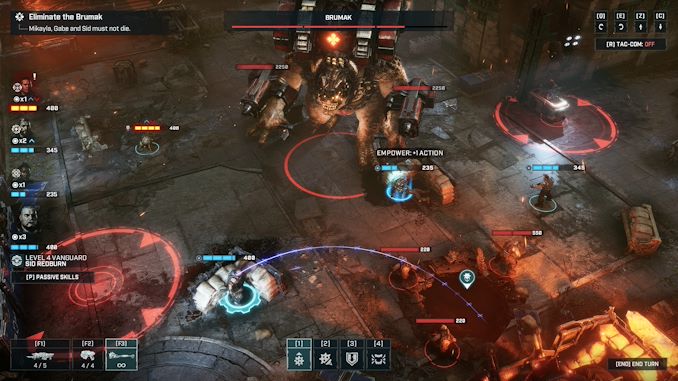









541 Comments
View All Comments
blppt - Saturday, March 13, 2021 - link
They did try to at least 'ride it out' until Zen could get done, and that required smoothing out the rough edges, so they did devote some resources.BD/PD never did any better than a low-end solution for the desktop/laptop market, but they had to offer something until Zen was done.
Oxford Guy - Sunday, March 28, 2021 - link
'They did try to at least 'ride it out' until Zen could get done, and that required smoothing out the rough edges, so they did devote some resources.'Wow... watch the goal posts move.
Riding out = doing nothing. Piledriver was not improved. The entire higher-performance & supercomputer market was unchanged from Piledriver to Zen. All AMD did was ship cheap knock-off APU rubbish and console trash.
The fact that AMD succeeded with Zen is probably mostly a testament to one largely ignored feature of monopoly power: the monopolist can become so slow and inefficient that a nearly dead competitor can come back to best it. That's not symptomatic of a well-run economic system. It's a trainwreck.
AMD should have been wealthy enough to do proper R&D and bulldozer would have never happened in the first place. But, Intel was a huge abusive monopolist and everyone went right along, content to feed the problem. After AMD did Bulldozer and Piledriver the company should have been dead. If there had been adequate competition it would have been. So, ironically, AMD can thank Intel for being its only competition, for resting on its laurels because of its extreme monopolization.
GeoffreyA - Wednesday, March 10, 2021 - link
Oxford Guy. I don't remember the exact details and am running largely from memory here. Yes, I agree, Bulldozer had far lower IPC than Phenom, but, according to their belief, was supposed to restore them to the top and knock Intel down. In practice, it failed miserably and was worse even than Netburst. Credit must be given, however, for their raising Bulldozer's IPC a lot each generation (something like 20-30% if I remember right), and curtailing power. It also addressed weaknesses in K10 and surpassed K10's IPC eventually. Anyway, working against such a hopeless design surely taught them a lot; and pouring that knowledge into a classic x86 design, Zen, took it further than Skylake after just one iteration.AMD would have done better had they just persisted with K10, which wasn't that far behind Nehalem. But, perhaps we wouldn't have had Zen: it took AMD's going through the lowest depths, passing through the fire as it were, to become what they are today, leaving Intel baffled. I agree, they were truly idiotic in the last decade but no more. May it stay that way!
Concerning CMT, I don't know much about it to comment, but think Bulldozer's principal weakness came from sharing execution units---the FP units I believe and others---between modules. Zen kept each core separate and gave it full (and weighty) resources, along with a micro-op cache and other improvements. As for Jaguar, it may be junk from a desktop point of view, yes, but was excellent in its domain and left Atom in the dust.
Oxford Guy - Sunday, March 28, 2021 - link
'Credit must be given, however, for their raising Bulldozer's IPC a lot each generation (something like 20-30% if I remember right), and curtailing power.'Piledriver was a small IPC improvement and regressed in AVX. Piledriver's AVX was so extremely poor that it was faster to not use it. Piledriver was a massive power hog. The 32nm SOI process node, according to 'TheStilt' was improved over time which is probably the main source of power efficiency improvement in Piledriver versus Bulldozer. I do not recall the IPC improvement of Piledriver over Bulldozer but it was nothing close to 20% I think. Instead, it merely made it possible to raise clocks further, along with the aforementioned node improvement. And, 'TheStilt' said the node got better after Piledriver's first generation. The 'E' parts, for instance, were quite a lot improved in leakage — but the whole line (other than the 9000 series which he said should have been sent to the scrapper) improved in leakage. What didn't improve, sadly, is the bad Piledriver design. AMD never bothered to fix it.
While Piledriver, when clocked high (like 4.7 GHz) could be relevant against Sandy in multi-thread (including well-threaded games like Desert of Kharak) it was extremely pitiful in single-thread. And, it sucked down boatloads of power to get to 4.7, even with the best-leakage chips.
And, going back to your 20–30% claim. Steamroller, which was considered a serious disappointment, featured only 4 of the CMT quasi cores, not 8. Excavator cut things in cache land even further. Both were cost-cutting parts, not performance improvements. Piledriver killed both of them simply by turning up the clocks high. The multi-thread performance of Steamroller and Excavator was not competitive because of the lack of cache, lack of cores, and lack of clock. Single-thread was a bit improved but, again, the only thing one could really do was blast current through Piledriver. It was a disgusting situation due to the single-threaded performance, which was unacceptable in 2012 and an abomination for the later years AMD kept peddling Piledriver in.
The only credit AMD deserves for the construction core period is not going out of business, despite trying so hard to do that.
GeoffreyA - Sunday, March 28, 2021 - link
Oxford Guy, while I respect your view, I do not agree with it, and still stand by my statement that AMD deserves credit for improving Bulldozer and executing yearly. Agreed, my 20-30% claim was not sober but I just meant it as a recollection and did qualify my statement.I don't think it's fair to put AMD down for embarking on Bulldozer. When they set out, quite likely they thought it was going to go further than the aging Phenom/K10 design, and the fact is, while falling behind in IPC compared with K10, it improved on a lot of points and laid the foundation. Its chief weakness was the idea of sharing resources, like the fetch, decode, and FP units, as well as going for a deeper pipeline. (The difference from Netburst is that Bulldozer was decently wide.)
Piledriver refined the foundation, raising IPC and adding a perceptron branch predictor, still used in Zen by the way, and I believe finally surpassed K10's IPC (and that of Llano). While being made on the same 32 nm process, it dropped power by switching to hard-edge flip flops, which took some work to put in. They used that lowered power to raise clock speeds, bringing power to the same level as Bulldozer. And Trinity, the Piledriver APU, surpassed Llano. I need to learn more about Steamroller and Excavator before I comment, but note in passing that SR improved the architecture again, giving each integer core its own fetch/decode units, among other things; and Excavator switched to GPU libraries in laying out the circuitry, dropping power and area, the tradeoff being lower frequency.
GeoffreyA - Sunday, March 28, 2021 - link
Also, the reviews show that things were not as bad as we remember, though power was terrible.https://www.anandtech.com/show/6396/the-vishera-re...
https://www.anandtech.com/show/5831/amd-trinity-re...
Oxford Guy - Tuesday, April 6, 2021 - link
I don't need to look at reviews agaih. I know how bad the IPC was in Bulldozer, Piledriver, Steamroller, and Excavator. Single-thread in Cinebench R15, for instance, was really low even at 5.2 GHz in Piledriver. It takes chilled water to get it to bench at that clock.GeoffreyA - Wednesday, March 10, 2021 - link
Lack of competition, high prices, lack of integrity. I agree it's one big mess, but there's so little we can do, except boycotting their products. As it stands, the best advice is likely: find a product at a decent price, buy it, be happy, and let these rotten companies do what they want.Oxford Guy - Sunday, March 28, 2021 - link
'find a product at a decent price, buy it, be happy'Buy a product you can't buy so you can prop up monopolies that cause the problem of shortage + bad pricing + low choice (features to choose from/i.e. innovation, limited).
GeoffreyA - Sunday, March 28, 2021 - link
The only solution is a worldwide boycott of their products, till they drop their prices, etc.